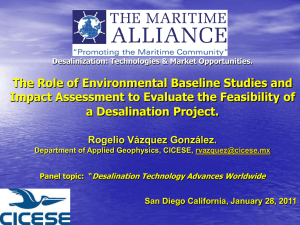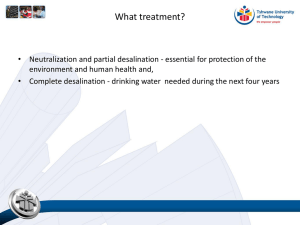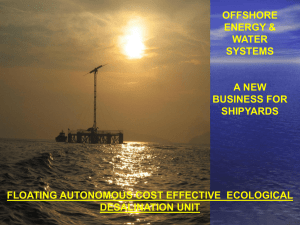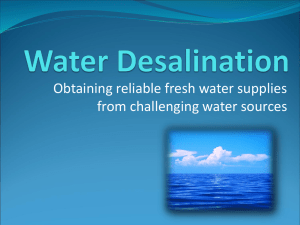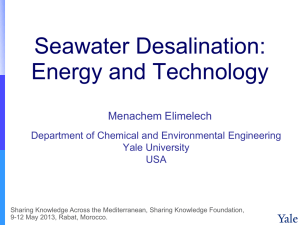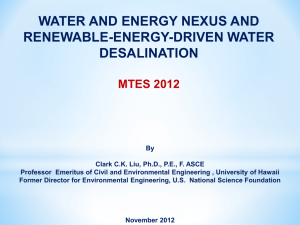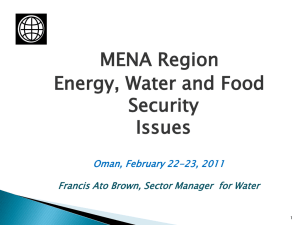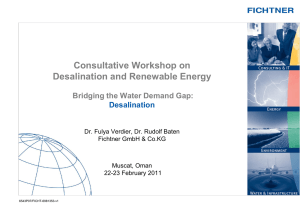DESALINATION OF WATER
advertisement
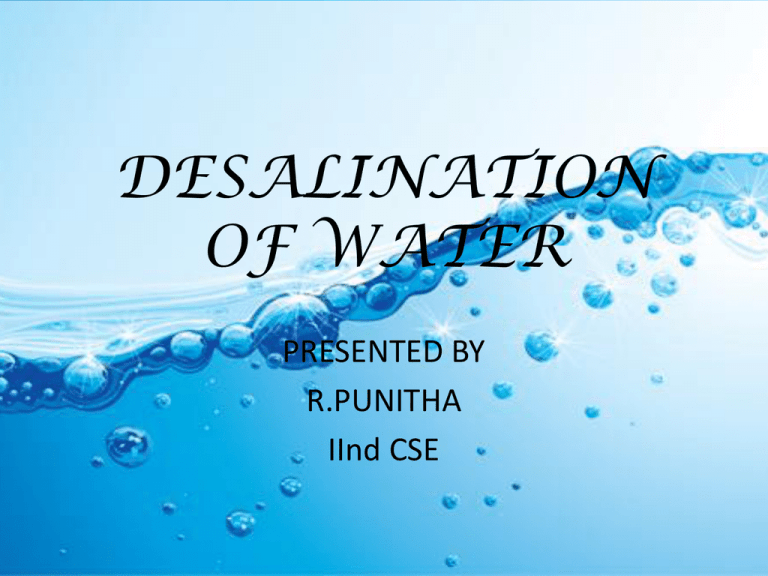
DESALINATION OF WATER PRESENTED BY R.PUNITHA IInd CSE CONTENTS Definition Desalination plants Vacuum distillation Cogeneration Professor Nolan hertel Economics Low temperature thermal desalination • Kavaratti plant • Thermo ionic process • Conclusion • • • • • • • DEFINITION • Desalination is a process that remove some amount of salt and other minerals from saline water • Water is desalinated in order to convert salt water to fresh water so it is suitable for human consumption • Desalination is used on many seagoing ships and submarines • Large scale desalination uses extremely large amount of energy as well as specialized , expensive infrastructure • By making it very costly compare to the use of fresh water from conventional sources such as rivers or ground water. DESALINATION PLANT JEBEL ALI DESALINATION PLANTS • The world’s largest desalination plant is the Jebel Ali desalination plant ( phase 2 ) in the united Arab Emirates • It uses multi-stage distillation and is capable of producing 300 million cubic meters of water per year TAMPA BAY DESALINATION PLANT • By comparison the largest desalination plant in the united states is located in Tampa bay , Florida & operated by Tampa bay water • The Tampa bay plant runs at around 12% the output of the jebel ali desalination plant • The Tampa bay producing 34.7 million cubic meters per year VACUUM DISTILLATION • The traditional process used in these operations is vacuum distillation , essentially the boiling of water at less than atmospheric pressure and thus a much lower temperature than normal • Distillation is a technique by which two or more substances with different boiling point can be separated from each other COGENERATION • Cogeneration is a process of using excess heat from power production to accomplish another task • It is a production of portable water from sea water or brackish ground water in an integrated facility in which a power plant is used as the source of energy for the desalination process PROFESSOR NOLAN HERTEL • The Atlanta journal constitution, Nolan Hertel a professor of nuclear and radio logical engineering at Georgia tech wrote nuclear reactors can be used to produce large amount of portable water • The process is already in use in a number of places around the world from India to Japan and Russia • Eight nuclear reactors are coupled to desalination plants are operating in Japan • A typical aircraft carrier in the U.S military uses nuclear power to desalinate 400000 U.S Gallons ECONOMICS • A number of factors determine the capital and the operating cost for the desalination 1. capacity 2. types of facility 3. location 4. feed water 5. labor 6. energy 7. financing and concentrate disposal • Desalination stills now control pressure , temperature and brine concentration to optimize the water extraction efficiency • Israel is now desalinating water at a cost of US$0.53 per cubic meter • Singapore is desalinating water for US$0.49 per cubic meter • Many large coastal cities in developed countries are considering the feasibility of sea water desalination due to its cost effectiveness PERTH DESALINATION PLANT • The Perth desalination plant is powered partially by renewable energy from the Emu Downs Wind Farm • A wind farm at Bungendore in NSW has been purpose built to generate enough renewable energy to offset the energy use of the Sydney plant LOW TEMPERATURE THERMAL DESALINATION • The principle of LTTD has been known for a long time originally stemming from ocean thermal energy conversion research • Some experiments were conducted in US and Japan to test the low temperature driven desalination technology Thermo-ionic process • The Thermo-Ionic™ process works by first evaporating salt water to air to create a hyper-salty solution which holds energy relative to the original salt water. • Evaporation is achieved in a modified cooling tower or spray pond by harnessing low grade heat from renewable sources such as the sun or waste heat rejected by an industrial process • The Salt-Maker, also built largely from plastics, accepts Thermo-Ionic's highly concentrated reject, removes remaining water, and produces solid salt. • Powered with low grade waste heat only 10 deg Celsius warmer than ambient, it operates a fraction of the electrical energy consumption of conventional crystallizers. SAVE WATER

